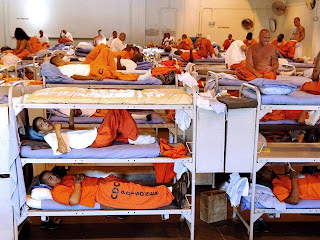TLP: Sometimes, the Lowest Bidder is Low For a Reason
Courtesy of Jr. Deputy Accountant
Privatization of government services has it place. Trash pickup? Sure. IT? Makes sense. State prisons? Eh, maybe not so much.
Early this month, three convicted murderers escaped from a prison in Kingman, a small town along Route 66 in northwest Arizona. According to reports, the inmates had broken free from the facility by using a pair of wire cutters. They’d escaped from a medium-security facility operated by Utah-based Management & Training Corp, a private corrections company.
The incident set off a political furor, not over the fact that the three violent criminals were being held in a medium-security prison, but over the security of the facility itself, and, ultimately, over Arizona’s widespread use of private correctional facilities.
Arizona’s attorney general, Terry Goddard, a Democrat running for governor against incumbent Republican Janice Brewer, took the opportunity to indict the state’s infatuation with privatization.
"I believe a big part of our problem is that the very violent inmates, like the three that escaped, ended up getting reclassified [as a lower risk] quickly and sent to private prisons that were just not up to the job," Goddard told a local TV news station.
In recent years, the trend toward privatization, both among state governments and at the federal level has been part of an attempt to address serious budget troubles and crisis-level prison overcrowding by outsourcing more and more corrections operations to private companies.
The move has translated into big business for industry leaders like Corrections Corporation of America (CXW), The Geo Group (GEO) and Cornell Companies, Inc. (CRN) (just last week, The Geo Group and Cornell finalized a merger valued at $730 million).
According to research firm IBISWorld USA, private corrections is a $22.7 billion industry with an annual growth rate in the last half-decade of 4.7%. While growth slowed from 2009 to 2010, projections for the industry remain largely optimistic.
"The prison population continues to grow regardless of what the economic conditions are," says George Van Horn, senior analyst at IBISWorld.
According to the Bureau of Justice Statistics, the number of federal inmates housed in private facilities jumped nearly 14% between 2000 and 2007, and nearly 6% between 2007 and 2008.
Of course, there are ways government can deal with this problem. Make an effort to keep an eye on the companies hired to run private lockups. Suck it up and pay the cost of building and staffing prisons. Or perhaps think about whoreally needs to be behind bars. Maybe a few less hookers and pot-smokers being fed and housed by Arizona taxpayers would have kept the state from farming out the prison work.



